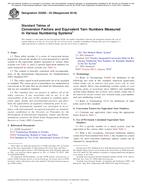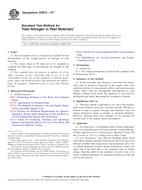1.1 This practice presents a laboratory procedure to determine the thermal resistance of attic insulation systems under simulated steady-state winter conditions. The practice applies only to attic insulation systems that face an open attic air space.
1.2 The thermal resistance of the insulation is inferred from calculations based on measurements on a ceiling system consisting of components consistent with the system being studied. For example, such a system might consist of a gypsum board or plywood ceiling, wood ceiling joists, and attic insulation with its top exposed to an open air space. The temperature applied to the gypsum board or plywood shall be in the range of 18 to 24°C (64 to 75°F). The air temperature above the insulation shall correspond to winter conditions and may range from -46°C to 10°C (-51 to 50°F). The gypsum board or plywood ceiling shall be sealed to prevent direct airflow between the warm an cold sides of the system.
1.3 This practice applies to a wide variety of loose-fill or blanket thermal insulation products including fibrous glass, rock/slag wool, or cellulosic fiber materials; granular types including vermiculite and perlite; pelletized products; and any other insulation material that may be installed pneumatically or poured in place. The practice considers the effects on heat for example, gypsum board, air films, and possible facings, films, or other materials that may abe used in conjunction with the insulation.
1.4 This practice measures the thermal resistance of the attic/ceiling system in which the insulation material has been preconditioned according to the material Specifications C549, C665, C739, and C764.
1.5 The specimen preparation techniques outlined in this standard do not cover the characterization of loose-fill materials intended for enclosed applications.
1.6 This practice may be used to characterize material behavior under controlled steady-state laboratory conditions intended to simulate actual temperature conditions of use. The practice does not simulate forced air flow conditions.
1.7 All values shall be reported in both SI units and inch-pound units unless specified otherwise by the client.
1.8 This standard does not purport to address all of the safety concerns, if any, associated with its use. It is the responsibility of the user of this standard to establish appropriate safety and health practices and determine the applicability of regulatory limitations prior to use.
Product Details
- Published:
- 01/01/1998
- Number of Pages:
- 8
- File Size:
- 1 file , 83 KB


